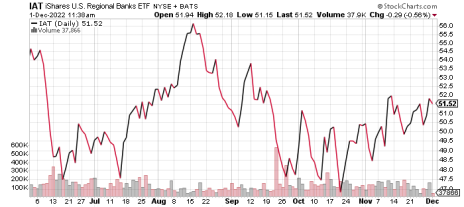Interest rates are rising. They will very likely continue to do so. Higher rates are bad for most companies. But certain companies and their stocks actually benefit. Which is why today I’m recommending a regional bank ETF. More on that in a minute...
Even with the torrid pace of rate hikes, both long- and short-term rates are still well below the average levels of the past several decades. Yet, the economy remains strong. Plus, there’s inflation.
Inflation has persisted over the past year and has blossomed into a huge problem. Ideally, the Fed seeks an inflation rate of around 2%. But prices have been increasing at more than a 5% annual rate for more than a year. The October number came in at 7.7% and remains near the highest inflation in 40 years.
[text_ad]
In normal and efficient markets, a strong economy and steeply rising prices would drive interest rates much higher. But rates have been held down and distorted by the Fed’s hyper-aggressive accommodation. And the Fed is reversing course.
The central bank sets the benchmark short-term Fed Funds rate, currently at 3.75% to 4%. It has also employed a $120 billion per month bond-buying program, which has the effect of holding longer-term interest rates lower. On top of raising the Fed Funds rates, the Fed has been working on quantitative tightening by allowing assets on its balance sheet to mature without replacing them.
With the backstop of the Fed removed, market forces will likely drive interest rates higher, and perhaps a lot higher. The risk is particularly high with longer-term interest rates.
As the Fed raises short-term rates, it will likely run into trouble. At a certain point, the market will react negatively. At that point, the central bank may find it counterproductive. There will be limits on how much they can raise short-term rates. But longer rates are a different story.
The Fed can control shorter rates, as it sets the benchmark Fed Funds rate. But market forces determine longer rates. True, the bond buying program has the effect of holding longer rates down, but that’s ending. The market will determine longer-term rates now. And if inflation persists, investors will demand higher rates to keep pace.
The situation is likely to raise the interest rate spread between long- and short-term rates. While that might be a negative situation for the overall market, certain stocks tend to thrive when rates go higher and the yield curve steepens. Regional banks are a main beneficiary as most of their profits are derived from net interest income, the difference in the short-term rates at which they borrow and the longer rates they charge for loans.
That brings me to my favorite regional bank ETF…
The Best Regional Bank ETF: iShares U.S. Regional Banks ETF (IAT)
The iShares U.S. Regional Banks ETF (IAT) is a fund that tracks an index of regional banks in the United States. The portfolio currently comprises 38 mostly small and midsized banks. It has a very low annual expense ratio of just 0.39%.
Regional banks serve the local community by providing checking and savings accounts, personal and commercial loans, mortgages, and other services. While the big banks derive much of their profits from investments and trading activities, these smaller banks are simpler. The lion’s share of profits are derived from net interest income.
Net interest income is quite simply the difference or spread between the rates at which banks borrow money and the interest they charge. Banks generally borrow at short-term rates and lend at longer-term rates, plus a sizable premium. The bigger the difference between short and longer rates (the yield curve), the higher the profits.
The current yield curve inversion (when short rates are higher than long rates) is a drag on the net interest income, but should resolve as we get more clarity from the Fed and a clearer picture of a potential recession.
Owning regional bank stocks is an excellent way to derive a benefit from rising interest rates, while the phenomenon is a negative for most other stocks. It provides diversification and defense from higher rates in a portfolio. But most regional banks are small and reflect peculiarities in their region that could obscure the benefit of a steepening yield curve. That’s why a diversified fund is a great vehicle.
IAT enables you to invest in a portfolio of 38 U.S. regional banks, thus greatly reducing the risks associated with buying one small bank stock. Top holdings (as of November 30) include PNC Financial Services Group (PNC) (12.57%), U.S. Bancorp (USB) (11.18%), Truist Financial Corp. (TFC) (11.31%), and M&T Bank (MTB) (5.44%). As you can see, the portfolio percentages really drop off after the top three, which represent 35.06% of the portfolio.
The top holdings are also the largest banks. The top five stocks account for 45.09% and the top 10 are 64.05% of the portfolio. The rest of the portfolio is mostly midsized and small banks. It makes sense because the bigger banks cover wider regions and present less localized risk.
As for the ETF itself, it yields 2.8% and it’s up 2% in the last month, underperforming the S&P (up 5.6%), but if the Fed is committed to allowing assets to mature off its balance sheet and inflation remains elevated, we would expect IAT to begin outperforming.
Do you own any other regional bank ETFs or stocks? Let us know about them in the comments below!
[author_ad]


